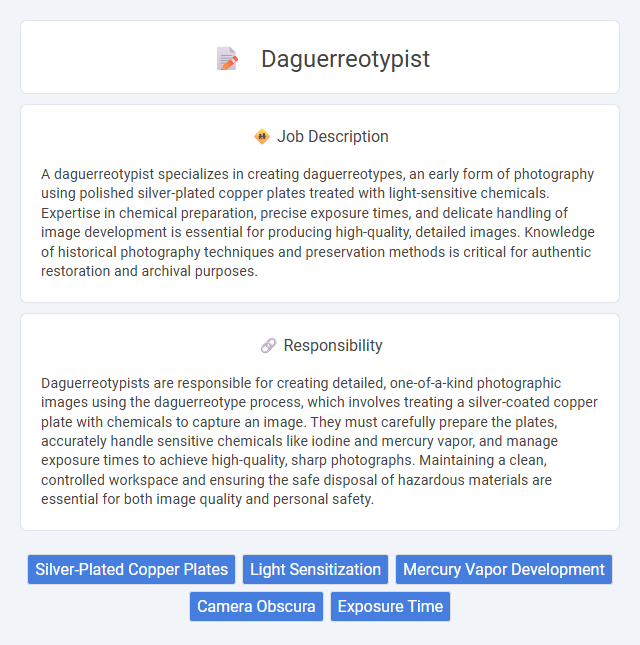
A daguerreotypist specializes in creating daguerreotypes, an early form of photography using polished silver-plated copper plates treated with light-sensitive chemicals. Expertise in chemical preparation, precise exposure times, and delicate handling of image development is essential for producing high-quality, detailed images. Knowledge of historical photography techniques and preservation methods is critical for authentic restoration and archival purposes.
Daguerreotypists likely need strong attention to detail and patience, as the process involves delicate handling of chemicals and precise timing. Individuals with steady hands and a calm demeanor may be more suitable for this meticulous and often time-consuming work. Those who find comfort in repetitive tasks and have an interest in historical photographic techniques might be more inclined to thrive in this occupation.
Qualification
A daguerreotypist must possess expertise in early photographic techniques, specifically the daguerreotype process involving polished silver-plated copper sheets. Proficiency in handling sensitive chemicals, such as iodine and mercury vapors, and precise timing to develop high-quality images is essential. Strong attention to detail and steady hands are crucial for producing sharp, detailed photographs without damage or contamination.
Responsibility
Daguerreotypists are responsible for creating detailed, one-of-a-kind photographic images using the daguerreotype process, which involves treating a silver-coated copper plate with chemicals to capture an image. They must carefully prepare the plates, accurately handle sensitive chemicals like iodine and mercury vapor, and manage exposure times to achieve high-quality, sharp photographs. Maintaining a clean, controlled workspace and ensuring the safe disposal of hazardous materials are essential for both image quality and personal safety.
Benefit
The Daguerreotypist job likely offers the benefit of preserving historical moments through a unique and intricate photographic process. Skilled practitioners may experience a high probability of finding niche opportunities in museums, art galleries, or vintage photography studios. This role potentially enhances artistic expression and technical expertise in an increasingly rare and sought-after craft.
Challenge
Daguerreotypists likely encounter challenges related to the intricate chemical processes required to produce high-quality images, which demand precision and patience. The sensitivity of early photographic plates to light and environmental conditions probably increases the risk of errors or damaged results. Mastering the meticulous steps involved may require significant practice and a steady hand to consistently achieve clear, detailed photographs.
Career Advancement
Daguerreotypists with advanced skills in chemical processing and restoration techniques often transition into roles as photographic conservators or fine art restoration specialists. Mastery of historical photographic methods can lead to opportunities in museums, galleries, and academic institutions, where expertise in early photography is highly valued. Continuous learning in digital imaging and archival practices enhances prospects for leadership positions within preservation and cultural heritage organizations.
Key Terms
Silver-Plated Copper Plates
Daguerreotypists specialized in creating detailed photographic images on silver-plated copper plates, a pioneering method in early photography. The silver-plated copper plate served as the base for exposing light-sensitive chemicals, allowing for highly detailed and reflective images with a unique mirror-like finish. Mastery in preparing and handling these plates was essential for producing durable and sharp daguerreotypes, making the technique a crucial step in 19th-century photographic innovation.
Light Sensitization
Daguerreotypists specialize in the early photographic process of light sensitization, utilizing silver-coated copper plates treated with iodine vapor to create a light-sensitive surface. Precise control of exposure to light is critical, as the plates react chemically to capture a latent image, which is subsequently developed using mercury vapor to reveal a detailed, mirror-like photograph. Mastery of light sensitization techniques ensures the clarity and quality of each daguerreotype, making it a highly specialized skill within historical photography.
Mercury Vapor Development
A daguerreotypist specialized in mercury vapor development expertly handles the chemical process of exposing a silver-coated copper plate to mercury fumes, which fuses the image onto the surface with exceptional detail. This technique requires precise temperature control and timing to ensure the mercury vapors react correctly, producing the iconic mirror-like images characteristic of this early photographic method. Mastery of mercury vapor development significantly impacts image clarity and preservation, marking it as a critical skill in historical photographic craftsmanship.
Camera Obscura
A Daguerreotypist expertly operates the camera obscura to capture detailed images on silver-plated copper sheets using light-sensitive chemicals. Mastery of the camera obscura's optical principles ensures precise image focus and exposure critical to producing sharp, long-lasting photographs. This role demands technical skill in preparing and handling early photographic materials, as well as deep understanding of light manipulation within the camera obscura apparatus.
Exposure Time
Daguerreotypists specialized in creating early photographic images by carefully managing exposure time, which typically ranged from several seconds to several minutes depending on lighting conditions and the sensitivity of the silver-coated copper plates. Precision in exposure time was crucial to capture clear, detailed images, as overexposure could result in washed-out photos while underexposure led to dark, indistinct images. Mastery of this timing allowed daguerreotypists to produce high-quality portraits and still lifes during the 19th century's earliest era of photography.
 kuljobs.com
kuljobs.com